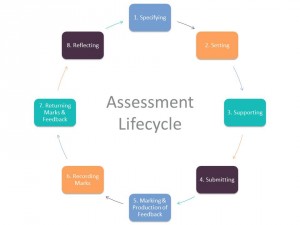5 Days of EMA with Turnitin – Day 1: Electronic Management of Assessment
What is EMA?
The term electronic management of assessment (EMA) is increasingly being used to describe the way in which technology is used across the assessment lifecycle to support the electronic submission of assignments, as well as marking and feedback.
Assessment and feedback involves the management of a complex set of business processes, especially in higher education . Many universities and colleges are seeing benefits and cost savings from using technology to support and to streamline these processes. This high level model shows the types of activity that can be supported through technology.
At a more detailed level, the processes also include: assessment scheduling; submission of assignments; tracking of submissions; extension requests and approvals; academic integrity; academic misconduct processes; examinations; marks recording; moderation and external examining.
This Jisc guide to Electronic Management of Assessment (EMA) draws on a body of work around assessment and feedback. It may be of interest to senior managers, academic staff, curriculum managers, administrators, and those involved in implementing and supporting technology-enhanced learning, assessment and feedback, and technology-enhanced business systems.
Turnitin
Turnitin is an electronic assignment submission web-service that enables tutors to carry out a comparison of students’ work against electronic sources. In addition, Turnitin has a range of marking and feedback features, making it much more than just a plagiarism detection tool.
The service can be accessed via our Virtual Learning Environment (VLE), Moodle. Tutors can choose to use a Turnitin assignment type in place of Moodle’s own assignment type. This service is a valuable support tool for staff and students in efforts improve to prevent and detect plagiarism. It is also available to students as a formative tool to aid in their understanding of academic integrity.
You can find out more about Turnitin on our Turnitin webpages, and more information on Assessment and Feedback is available on the ADD website.
Over the next five days, we’ll be exploring EMA, and in particular Turnitin, together. During each of the five days we’ll be sharing a daily post on a particular aspect of Turnitin and how it fits into the Assessment Lifecycle, to get you up and running and exploring what Turnitin can do. Throughout, we’ll be focusing very practically and specifically on what Turnitin can offer you. None of these activities will take up very much of your time, so we hope it will be a worthwhile experiment for you! We’ll be interacting with each other too here on the blog, so you’ll be engaging with us and other participants too!
Note: This course uses a York St John set-up of Turnitin, which integrates with our VLE, Moodle. Other institutions’ versions of Turnitin may be different. Participants external to York St John are welcome to follow the course, but we also advise you to contact Turnitin or your own support team for institution-specific guidance.
Activity
EMA is not without its challenges, whether they be administrative, technical or pedagogical! Take a look at the list of EMA challenges identified by JISC in the Electronic Management of Assessment: a landscape review (p40). From the list, select the top 3 challenges that you face with EMA and share them in the comments below.
Phil
References and Further Reading
JISC. 2015. Transforming Assessment and Feedback with Technology. [Online]. [Accessed 20 November 2015]. Available from: https://www.jisc.ac.uk/guides/transforming-assessment-and-feedback/
Electronic Management of Assessment (EMA): a landscape review [PDF]
Effective Assessment in a Digital Age: A guide to technology-enhanced assessment and feedback [PDF]
| Day 2: Creating a Turnitin Assignment >>> |



The biggest challenge we face is allocating double marking and verifying and keeping it all anonymous. We also have different centres for some courses, the marking ranges across these centres per course, and we use teachers to cross mark (e.g. Birmingham teachers will mark London Students’ essays). Again this is all done blind, using only the student number.